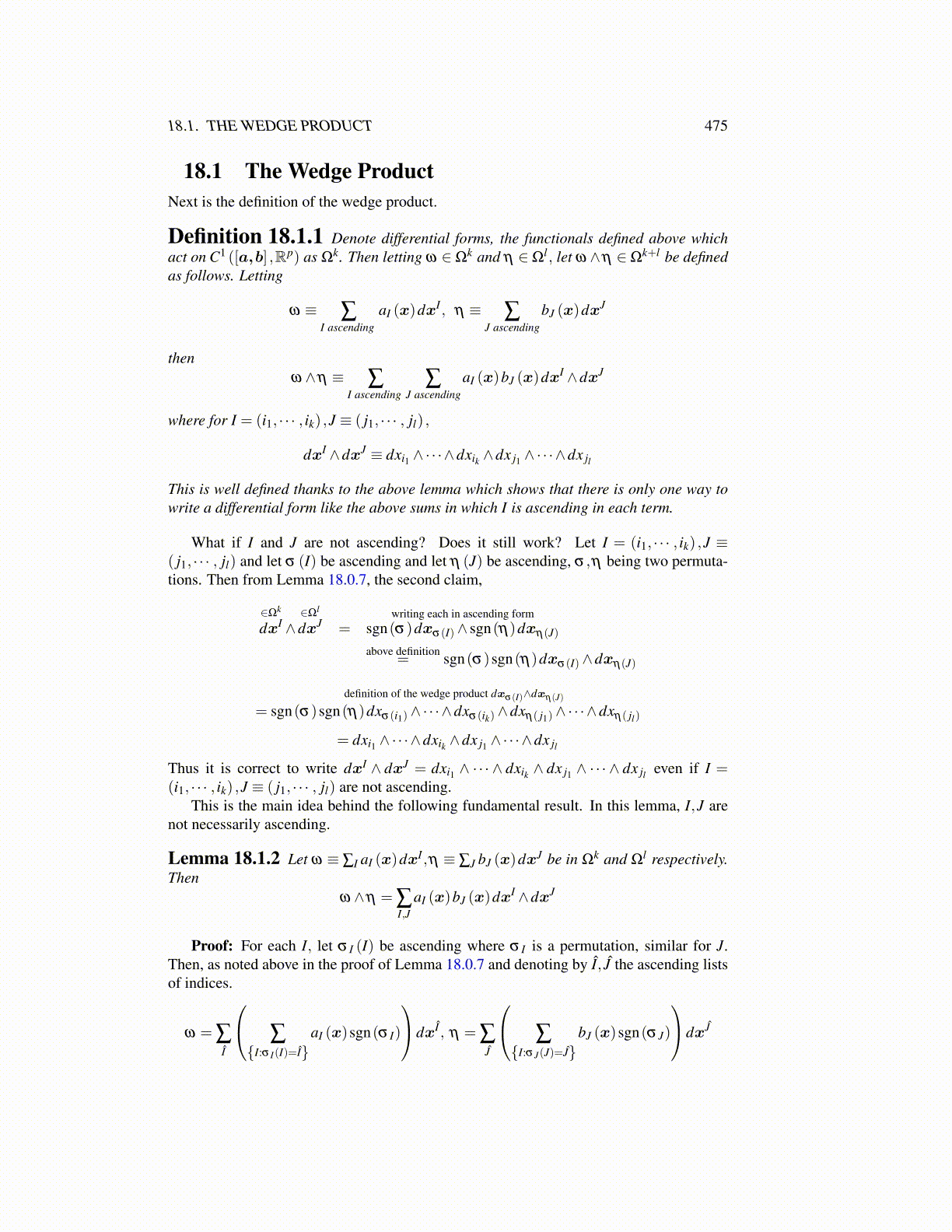
18.1. THE WEDGE PRODUCT 475
18.1 The Wedge ProductNext is the definition of the wedge product.
Definition 18.1.1 Denote differential forms, the functionals defined above whichact on C1 ([a,b] ,Rp) as Ωk. Then letting ω ∈Ωk and η ∈Ωl , let ω ∧η ∈Ωk+l be definedas follows. Letting
ω ≡ ∑I ascending
aI (x)dxI , η ≡ ∑J ascending
bJ (x)dxJ
thenω ∧η ≡ ∑
I ascending∑
J ascendingaI (x)bJ (x)dxI ∧dxJ
where for I = (i1, · · · , ik) ,J ≡ ( j1, · · · , jl) ,
dxI ∧dxJ ≡ dxi1 ∧·· ·∧dxik ∧dx j1 ∧·· ·∧dx jl
This is well defined thanks to the above lemma which shows that there is only one way towrite a differential form like the above sums in which I is ascending in each term.
What if I and J are not ascending? Does it still work? Let I = (i1, · · · , ik) ,J ≡( j1, · · · , jl) and let σ (I) be ascending and let η (J) be ascending, σ ,η being two permuta-tions. Then from Lemma 18.0.7, the second claim,
∈Ωk
dxI ∧∈Ωl
dxJ =writing each in ascending form
sgn(σ)dxσ(I)∧ sgn(η)dxη(J)
above definition= sgn(σ)sgn(η)dxσ(I)∧dxη(J)
=definition of the wedge product dxσ(I)∧dxη(J)
sgn(σ)sgn(η)dxσ(i1)∧·· ·∧dxσ(ik)∧dxη( j1)∧·· ·∧dxη( jl)
= dxi1 ∧·· ·∧dxik ∧dx j1 ∧·· ·∧dx jl
Thus it is correct to write dxI ∧ dxJ = dxi1 ∧ ·· · ∧ dxik ∧ dx j1 ∧ ·· · ∧ dx jl even if I =(i1, · · · , ik) ,J ≡ ( j1, · · · , jl) are not ascending.
This is the main idea behind the following fundamental result. In this lemma, I,J arenot necessarily ascending.
Lemma 18.1.2 Let ω ≡ ∑I aI (x)dxI ,η ≡ ∑J bJ (x)dxJ be in Ωk and Ωl respectively.Then
ω ∧η = ∑I,J
aI (x)bJ (x)dxI ∧dxJ
Proof: For each I, let σ I (I) be ascending where σ I is a permutation, similar for J.Then, as noted above in the proof of Lemma 18.0.7 and denoting by Î, Ĵ the ascending listsof indices.
ω = ∑Î
∑{I:σ I(I)=Î}
aI (x)sgn(σ I)
dxÎ , η = ∑Ĵ
∑{I:σ J(J)=Ĵ}
bJ (x)sgn(σ J)
dxĴ